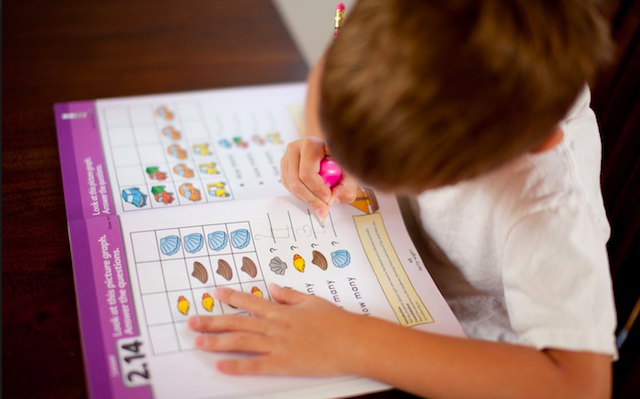Family interviews are underway for the next school year and at almost every one, families have questions about math. Things like, “My child is a high learner in math,” “My child is year behind in math, does he have to repeat the whole grade in every subject?” and “What if my child learns math at a slower pace?”
At The Classical Academy we want to change the way students think about and approach math. As a school we are committed to working hard to change the math culture that students are growing up in.
If classical education teaches students about truth, goodness, and beauty, how on earth does math fit into that? How do we teach them to see math in these ways? What really IS math? Isn’t math “black and white,” “a right answer or a wrong answer?” If you ask most students what they think their role is in a math classroom, they will tell you it is to get questions right. Students rarely think that they are in math classrooms to appreciate the beauty of mathematics, to ask deep questions, to explore the rich set of connections that make up the subject, or even to learn about the applicability of the subject. They think they are in math classrooms to perform. They think that math is a subject of calculations, procedures, and rules.
When asked what math is, students typically give descriptions that are very different from those given by experts in the field. I come from a family dedicated to education. My oldest sister teaches in higher education at an Ivy League school on the east coast, my Grandfather spent his career lifetime teaching in higher education in Boston, and his wife possesses two Ph.D’s, one in Mathematics, and one in Mechanical Engineering. She also teaches in higher education in Boston. Her description of math is not what the majority of students in U.S. classrooms describe as math. Mathematicians define their subject as the study of patterns. They say it is an aesthetic, creative, and beautiful subject.
That is not what most students believe about math. How do we help students see how the knowledge of mathematical patterns has helped people navigate oceans, chart missions to space, develop technology that powers cellphones and social networks, and create new scientific and medical knowledge? Those are the things we should answer with when students say, “Why do we have to learn math? I’m NEVER going to use this stuff.” At The Classical Academy, we want to pursue mathematics with truth, goodness, and beauty, so that our students aren’t even asking that question to begin with.
So what’s our plan? How do we begin to change the culture around learning math? How do we communicate an aesthetic, creative, and beautiful subject?
1. Choose a math curriculum that creates thinkers, not a curriculum that is good at teaching procedures and producing answers. After all, precise, memorized procedures and right answers aren’t what develops new technology, space missions, and new scientific and medical knowledge. There are no formulas in textbooks that produce those things. Mathematical thinkers produce those kinds of things.
2. Teach students from the beginning that “fast at math” doesn’t equal, “good at math.” The math culture in the majority of our schools (and even homeschools) subconsciously trains our students to believe that the best mathematical thinkers are those who calculate the fastest—that you have to be fast at math to be good at math. Yet mathematicians are often slow with math. My Grandpa’s wife will attest that most mathematicians are simply not fast math thinkers. This is not meant to be disrespectful to mathematicians. They are slow because they think carefully and deeply about mathematics. This is what we want our students to learn.
3. Pace students according to their ability. This is big for us at The Classical Academy, and relates back to number two. In our school program, students are placed into math according to their ability, not according to their grade. Math is at the same time, for every grade level, on every campus day. Students move among classrooms and math teachers in order to work where they are developmentally ready to work.
Parents and educators almost always automatically assume if their child isn’t in “this specific math class” by “this specific grade,” they are behind and can never pursue a career in math, engineering, or medicine. But, this is false. Again, some of the best mathematical thinkers, are some of the slowest mathematical thinkers. Just because your student takes longer to learn and understand math concepts doesn’t mean they’re doomed when it comes to pursuing their career dreams. Some students are ready in late high school to tackle calculus. Other students aren’t ready to tackle calculus until their brain is further along in development in their early 20’s in college. The latter also doesn’t mean that a career or degree rooted in “math” can’t be pursued as easily if they are tackling Calculus in college instead of 12th grade. We don’t help our students in any way, shape, or form, to push them along, or ahead, when they simply haven’t mastered what’s needed in order to move forward. When we do that we unintentionally frustrate them and ourselves. These are the kinds of scenarios that cause a math culture that produces students who “hate math” and who cannot even fathom math being applicable to “real life,” nevermind interwoven with truth, beauty, and goodness. All they see are black and white answers, answers that are only reserved for those who “think fast.” “Think fast” is not mathematical. And “think fast” is what we preach when we push our students through math to say they are “ahead.”
4. Our school model provides incredible opportunity to challenge the high learner and incredible opportunity to encourage the struggling learner. In the university-schedule school, students spend two days a week at school with professional teachers and classmates. Our teachers provide all the lesson plans for parents to privately tutor their students through their schoolwork on the other days of the week. This is akin to hiring a tutor to meet your child where they are at to complete schoolwork, except YOU know your child better than any private tutor you can hire!
The home day lessons to be completed can be done in the way your child learns best. For example: your child’s teacher sent home a lesson plan to work through about area and perimeter. You know your child learns best through visual and hands-on activities, so you move through the written lesson, tailoring the teaching to your student. High learner? Do more applications, add challenges. Struggling learner? Present it a different way, take your time, add reinforcements. The third home day is a flex day with light assigned schoolwork so that parents can do things like challenge their high math student with advanced material, or re-teach or spend some more time working through a concept with a struggling student without the stress of a school day time constraint.
At The Classical Academy, we have a phenomenal math program that provides a solid foundation in mathematics, by focusing on visual understanding, connections, number sense, mastery, word problems, and mental math. Our goal is to produce thinkers, not black and white test takers. Thinkers change the world. Test takers just give the right answers. Do you want to see your child approach all of life with the lens of truth, goodness, and beauty? Including something as “black and white” as mathematics? Come, check out the unique approach of our classical, Christian, collaborative education style.


